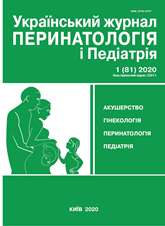Short intergenetic interval as a prerequisite for the occurrence of iron deficiency anemia in pregnant women
DOI:
https://doi.org/10.15574/PP.2020.81.59Keywords:
pregnancy, short intergenetic interval, anemia, Sorbifer DurulesAbstract
Purpose — to determine the effectiveness of correction of iron deficiency and treatment of iron deficiency anemia (IDA) in pregnant women with a short intergenetic interval.Patients and methods. The study included the treatment of 19 pregnant women with mild IDA with a short intergenetic interval. The pregnant women received the oral Sorbifer Durules from 20 weeks of pregnancy 1 tablet twice a day (4 mg/kg/day). The treatment efficacy was evaluated by the reticulocyte count on days 8–12 of treatment, by the hemoglobin concentration at 3–4 weeks of treatment and in terms of ferritin for the third month of antianemic treatment.
Results. After treatment of pregnant women with a short intergenetic interval and mild iron deficiency anemia, reticulocytic crisis was observed on the 8–12th day to 0.6±0.01%, which and indicates the effectiveness of treatment. Increasing the hemoglobin more than 20 g/l was observed after 3–4 weeks, the restoration of iron deficiency (by ferritin level) — after 3 months of treatment. There were no side effects in 16 (84.2%) in women, restoration of daily activity in 100% of pregnant women. In the vast majority of pregnant women, a positive result occurs after 10 days of treatment, which is confirmed by laboratory data and indicates the high effectiveness of the drug.
Conclusions. Due to the fact that iron deficiency states of a pregnant woman lead to a high incidence of obstetric and perinatal complications, the issue of preventing iron deficiency and treating iron deficiency anemia during pregnancy is an urgent issue. Sorbifer Durules has a proven safety profile and minimal side effects and recommended for the treatment of iron deficiency anemia and the prevention of iron deficiency in pregnant women.
The research was carried out in accordance with the principles of the Helsinki Declaration. The study protocol was approved by the Local Ethics Committee of this Institute. The informed consent of the patient was obtained for conducting the studies.
No conflict of interest were declared by the authors.
References
Davydova I, Limanskaya A, Butenko L. (2016). Prevention of infectious complications after cesarean section in women with congenital heart disease and anemia. Perinatologiya i pediatriya. 3(67): 15–19. https://doi.org/10.15574/PP.2016.67.15
Davydova IuV, Ogorodnyk AA, Limancka AYu, Bayder AK, Butenko LP. (2017). Prophylactics of obstetric disorders in anemia of chronic disease. Perinatologiya i pediatriya. 2(70): 37–41. https://doi.org/10.15574/PP.2017.70.37
Ogorodnyk AO, Limanskaya АYu, Butenko LP, Davydova IuV. (2018). Correction of iron deficiency in pregnant women with congenital heart defects, heart failure and anaemia. Perinatologiya i pediatriya. 3(75): 31–34. https://doi.org/10.15574/PP.2018.75.31
Friedrisch JR, Friedrisch BK. (2017). Prophylactic Iron Supplementation in Pregnancy: A Controversial Issue. Biochem Insights. 27: 10. https://doi.org/10.1177/1178626417737738; PMid:29123406 PMCid:PMC5661664.
Sun D, McLeod A, Gandhi S et al. (2017). Anemia in Pregnancy: A Pragmatic Approach. Obstet Gynecol Surv. 72 (12): 730–737. https://doi.org/10.1097/OGX.0000000000000510; PMid:29280474.
Bencaiova G, Burkhardt T, Breymann C. (2012). Anemia — prevalence and risk factors in pregnancy. Eur J Intern Med. 23 (6): 529–533. https://doi.org/10.1016/j.ejim.2012.04.008; PMid:22863430
Di Renzo GC, Spano F, Giardina I et al. (2015). Iron deficiency anemia in pregnancy. Womens Health (Lond). 11 (6): 891–900. https://doi.org/10.2217/whe.15.35; PMid:26472066. Epub 2015 Oct 16.
Ren A, Wang J, Ye RW et al. (2007). Low first-trimester hemoglobin and low birth weight, preterm birth and small for gestational age newborns. Int J Gynaecol Obstet. 98: 124. https://doi.org/10.1016/j.ijgo.2007.05.011; PMid:17585914
Kidanto HL, Mogren I, Lindmark G et al. (2009). Risks for preterm delivery and low birth weight are independently increased by severity of maternal anaemia. S Afr Med J. 99 (2): 98.
Badfar G, Shohani M, Soleymani A, Azami M. (2017). Maternal anemia during pregnancy and small for gestational age: A systematic review and meta-analysis. J Matern Fetal Neonatal Med. 1: 131. https://doi.org/10.1080/14767058.2017.1411477; PMid:29183181.
Taylor CL, Brannon PM. (2017). Introduction to workshop on iron screening and supplementation in iron-replete pregnant women and young children. Am J Clin Nutr. 106 (Suppl 6): 1547–1554. https://doi.org/10.3945/ajcn.117.155747; PMid:29070553 PMCid:PMC5701712.
Lozoff B. (2007). Iron deficiency and child development. Food Nutr Bull. 28: 560-571. https://doi.org/10.1177/15648265070284S409; PMid:18297894
Shao J, Lou J, Rao R. et al. (2012). Maternal serum ferritin concentration is positively associated with newborn iron stores in women with low ferritin status in late pregnancy. J Nutr. 142(11): 2004–2009. https://doi.org/10.3945/jn.112.162362; PMid:23014493 PMCid:PMC3498973
WHO. (2005). Report of a WHO Technical Consultation on Birth Spacing. Geneva, Switzerland, 13–15 June 2005.
Downloads
Issue
Section
License
The policy of the Journal “Ukrainian Journal of Perinatology and Pediatrics” is compatible with the vast majority of funders' of open access and self-archiving policies. The journal provides immediate open access route being convinced that everyone – not only scientists - can benefit from research results, and publishes articles exclusively under open access distribution, with a Creative Commons Attribution-Noncommercial 4.0 international license(СС BY-NC).
Authors transfer the copyright to the Journal “MODERN PEDIATRICS. UKRAINE” when the manuscript is accepted for publication. Authors declare that this manuscript has not been published nor is under simultaneous consideration for publication elsewhere. After publication, the articles become freely available on-line to the public.
Readers have the right to use, distribute, and reproduce articles in any medium, provided the articles and the journal are properly cited.
The use of published materials for commercial purposes is strongly prohibited.

